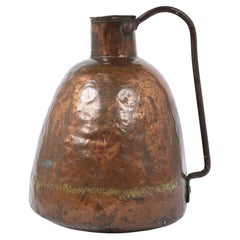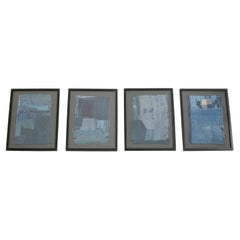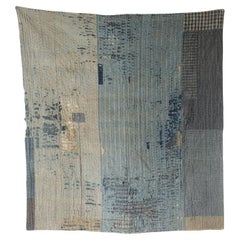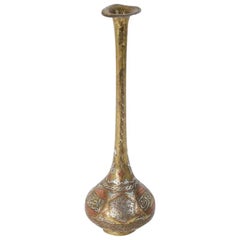Sauce Asian Art and Furniture
to
2
2
1
1
1
1
1
1
1
1
1
1
1
1
1
2
2
2
19th Century Copper & Iron Water Vessel, Algerian, c. 1890
Located in London, GB
A large, beautifully patinated late 19th century water pitcher or vessel, of dovetailed copper construction with forged iron handle. Indistinctly engraved ??? to the neck, meaning ‘u...
Category
Antique Late 19th Century Algerian Jars
Materials
Copper, Iron
Early 20th Century Boro Cloth Fragments, Japanese, C. 1900
Located in London, GB
A collection of late 19th/early 20th century indigo dyed ‘boro’ cloth fragments. Japanese, c. 1900. Mounted on anthracite grey card in box frames with black...
Category
Early 20th Century Japanese Textiles
Materials
Fabric, Textile
Related Items
Japanese Antiques Primitive Art BORO Indigo-dyed Sashiko Old Cloth
Located in Niiza, JP
1700(W)× 1550(D) [mm] Cotton
This is a highly sensitive old folk craft called "BORO" overseas.
It was a very poor time, and throwing things away was outrageous.
Old cloth that was c...
Category
Antique Early 19th Century Japanese Textiles
Materials
Cotton
$2,000
H 59.06 in W 66.93 in D 0.4 in
Middle Eastern Islamic Brass Inlaid Decorative Vase Moorish Style 19th C.
Located in North Hollywood, CA
Antique 19th century decorative beautiful and unusual Middle Eastern Islamic Moorish brass inlaid decorative vase with flared lip engraved and inlaid with silver and copper compound.
Engraved and decorated with very fine Moorish Islamic designs in Arabic script, floral and organic designs in silver, copper and brass inlay with medallions inscription-filled surrounded by vegetal interlace and a band of foliate Arabesque patterns.
Mamluke Persian Revival style, Islamic inlay...
Category
Antique Late 19th Century Asian Moorish Metalwork
Materials
Silver, Brass, Copper
Early 20th Century Japanese Linen Go-Board Pattern Futon Cover
Located in Point Richmond, CA
Early 20th Century Japanese linen go-board pattern futon cover
A unique example of a game-themed textile, this 3-panel futon cover is woven of very fine...
Category
Early 20th Century Japanese Meiji Textiles
Materials
Hemp
Tibetan Thangka Depicting the Bhavacakra, Early 20th Century
Located in Ottawa, Ontario
A Tibetan Thangka Depicting
The Bhavacakra
Early 20th century,
Color on cloth.
A thangka showing the bhavacakra
with the ancient five cyclic realms of samsara in Buddhi...
Category
Early 20th Century Chinese Chinese Export Paintings and Screens
Materials
Linen
19th Century Middle Eastern Copper Ewer
Located in Basingstoke, Hampshire
A large highly decorative middle eastern copper ewer. Dating from the early 19th century, displaying a charming patination throughout.
Measures: Height...
Category
Antique 19th Century Asian Metalwork
Materials
Copper
Japanese Satsuma Tripod Censer, Koro, Meiji period, Early 20th Century, Japan
Located in Austin, TX
A small and finely decorated Japanese Satsuma tripod incense burner (koro), signed Kyozan, Meiji period, circa 1900, Japan.
The censer, koro, with a compressed body supported by t...
Category
Antique Early 1900s Japanese Meiji Ceramics
Materials
Stoneware
Hand Etched Egyptian Brass Vessel Jardiniere, 19th Century
By Mamluke
Located in North Hollywood, CA
Middle Eastern Egyptian hand etched polished brass vessel.
Could be used as a vase or Jardiniere, indoor or outdoor.
Arabic Mameluke revival style brass vessel with figural scenes and pyramid architectural and geometric designs hand-hammered on metal polished vessel.
Etched with figures of the Pharaoh and scenes from the ancient pharaonic period.
Great decorative collector antique Middle Eastern Egyptian Islamic metalwork folk art object brass bowl hand crafted by artisans.
Hand made in Egypt, 19th Century.
Category
Antique Late 19th Century Egyptian Islamic Metalwork
Materials
Brass, Copper
19th Century Indo Persian Mughal Tinned Copper Bowl
Located in North Hollywood, CA
Large 19th century tinned copper Indo Persian Mughal copper bowl vessel.
Great patina on handcrafted and embossed metal tin copper bowl with floral geo...
Category
Antique 19th Century Indian Moorish Metalwork
Materials
Bronze, Copper, Tin
Old African bark cloth/20th century/Mbuti Pygmy Barkcloth Textile
Located in Sammu-shi, Chiba
This cloth was made by the Mbuti people, a pygmy tribe living in the Democratic Republic of the Congo. The Mbuti are hunter-gatherers who live in the Ituri rainforest, a tropical rai...
Category
20th Century Congolese Other Textiles
Materials
Other
$1,000
H 34.65 in W 16.15 in D 0.08 in
Fabric Divider, Cotton Noren with Kakumoji Character, Japan, Early 20th Century
Located in Tokyo, Tokyo
This is a traditional Japanese noren (fabric shop curtain) dating to the Taisho period (1912–1926), crafted from cotton dyed with persimmon tannin (kaki...
Category
Early 20th Century Japanese Textiles
Materials
Cotton
$840
H 58.67 in W 38.98 in D 0.4 in
Antique 19th Century Cloisonne Chinese Vase
Located in London, GB
This Chinese vase is made of brass with a lovely enamel cloisonné floral design. The elegant vase sits on a narrow round base with a short funnel neck. The cloisonne floral and leaf ...
Category
Antique 19th Century Chinese Metalwork
Materials
Enamel
19th Century Japanese Bronze Vase With Gilt Decoration, Meiji Period
Located in Stamford, CT
19th century Meiji Period diminutive bronze vase with lovely etched and applied decoration. A raised gilt bird is shown flying above etched bamboo on one side, gilt applied lilies wi...
Category
Antique Late 19th Century Japanese Meiji Metalwork
Materials
Bronze



